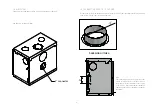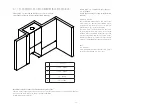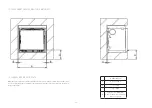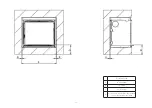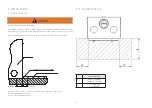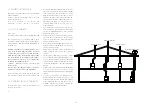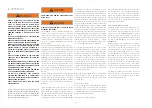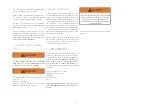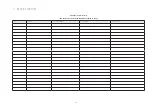
22
6.1 FIRE EXTINGUISHERS / SMOKE
DETECTORS
All homes with a solid fuel burning appliance should
have at least one fire extinguisher in a central location,
known to all, and at least one smoke detector in the
room containing the appliance. If it sounds an alarm,
correct the cause but do not de-activate or relocate
the smoke detector.
6.2 FUEL
WARNING
THIS APPLIANCE IS DESIGNED TO BURN NATURAL
WOOD ONLY. DO NOT BURN TREATED WOOD, COAL,
CHARCOAL, COLOURED PAPER, CARDBOARD, SOL-
VENTS OR GARBAGE. THIS APPLIANCE HAS NOT
BEEN TESTED WITH AN UNVENTED GAS LOG SET. TO
REDUCE RISK OF FIRE OR INJURY, DO NOT INSTALL
AN UNVENTED GAS LOG SET INTO THE APPLIANCE.
HIGHER EFFICIENCIES AND LOWER EMISSIONS
GENERALLY RESULT WHEN BURNING AIR DRIED
SEASONED HARDWOODS, AS COMPARED TO SOFT-
WOODS OR TOO GREEN OR FRESHLY CUT HARD-
WOODS. DO NOT BURN GREEN OR FRESHLY CUT
WOOD.
BURNING WET UNSEASONED WOOD CAN CAUSE
EXCESSIVE CREOSOTE ACCUMULATION. WHEN
IGNITED IT CAN CAUSE A CHIMNEY FIRE THAT MAY
RESULT IN A SERIOUS HOUSE FIRE.
DO NOT STORE FUEL WITHIN THE CLEARANCE TO
COMBUSTIBLES, OR IN THE SPACE REQUIRED FOR
RE-FUELING AND ASH REMOVAL.
When loading the appliance, ensure that the upper
fibre baffles are not forced out of position. For max-
imum efficiency, when the appliance is throughly
hot, load it fully to the line of air inlet nozzles at the
backside of the firebox or, if not present, to 50% of the
fireboxes backside height and burn at a medium low
setting. The whiteness of the bricks and the cleanli-
ness of the glass are good indicators of your operating
efficiency. Not enough heat is produced when only a
few pieces of wood are burned or the wood may not
burn completely. Fuel for the appliance must not be
stored closer than the required clearances to combus-
tibles (heat sensitive material).
NEVER STORE WOOD IN THE ASH PAN COMPART-
MENT (IF APPLICABLE).
NOTE: WHEN LOADING THE APPLIANCE, ENSURE
TO KEEP FUEL BACK FROM THE GLASS. IF COALS
ARE TO ACCUMULATE ON THE FRONT LIP, THERE IS
A CHANCE THEY WILL FALL OUT WHEN THE DOOR
IS OPENED.
Burn only dry, clean unpainted wood that has been
seasoned. It produces more heat and less soot or cre-
osote. Freshly cut wood contains about 50% moisture
while after proper seasoning only about 20% of the
water remains. As wood is burned, this water boils off
consuming energy that should be used in heating. The
wetter the wood, the less heat is given off and the
more creosote is produced. Dry firewood has cracks in
the end of the grain. Both hardwood and softwood burn
equally well in this appliance but hardwood is denser,
will weigh more per cord and burn a little slower and
longer.
Firewood should be split, stacked in a manner that air
can get to all parts of it and covered in early spring to
be ready for burning that fall. Dry firewood has cracks
in the end grain.
Cut the wood so that it will fit horizontally, front to
back, making for easier loading and less of a likelihood
that the wood will roll onto the glass.
Manufactured firelogs made by compressing 100%
natural wood fibre can be safely used as fuel. Do not
use manufactured firelogs if they contain additives
such as paraffin, wax, binders etc. Never burn more
than two manufactured firelogs at a time.
Do’s
Dont’s
• Build a hot fire.
• Take ash out immediately. Let it
accumulate to a depth of at least
one inch. A good ash layer provides
for a longer lasting and better
burning fire.
• Use only dry wood.
• Burn wet wood
• Several pieces of medium
sized wood are better
than a few big pieces.
• Close the door too soon or damper
down too quickly. Burn one large
log rather than two or three smaller,
more reasonably sized logs.
• Clean chimney regularly.
• Burn at continually “low setting”, if
glass door is constantly blackened.
This means the Firebox temperature
is too low and energy is wasted by
incomplete combustion.
• Refuel frequently using
medium sized wood.
6.3 LIGHTING A FIRE
Lighting the fire in your masonry inserts is very easy if
you follow the instructions given below:
1. A fire may only be started in the wood insert when
the firebox lining has been correctly installed.
2. Turn off any air extraction ventilation (kitchen, bath-
room, WC etc.). This will avoid low pressure building
up in the installation room that can
affect the extraction of flue gases from the wood
insert. Check the combustion air supply (if required,
open the cover flap)!
3. Adjust the combustion air regulator to the far right,
and open the firebox door (swing open).
4. Place chopped wood into the middle of the firebox
using the funeral pyre method (use softwood).
Caution: The height of the wood pile must not exceed
the lower marking on the deflector plate!
5. Place standard firelighter cubes under
the wood pyre to help start the fire. (paper is not rec-
ommended because it burns too quickly and causes
ash to circulate).
6. Never use methylated spirits, petrol, oil or other
easily combustible liquids.
7. Light the fire using the firelighter cubes and, if
required, leave the firebox door open by approx. 3-5
cm. The fire should now light, burning
brightly and intensively.
8. When the kindling wood is burning well, add smaller
hardwood logs or larger softwood logs using the
funeral pyre method and close the door.
9. When the wooden logs are burning well, the air con-
trol lever can be set to a position in the middle.
10. You can find out more about the correct volume of
wood to add to the fire in the section ‘‘Volume of wood
to add per hour’’.
Lighting the fire in your masonry insert is very easy if
you follow the instructions given below:
1. A fire may only be started in the masonry insert
when the firebox lining has been correctly installed.
2. Turn off any air extraction ventilation (kitchen, bath-
room, WC etc.). This will avoid low pressure building
up in the installation room that can
Summary of Contents for 600-ZC
Page 19: ...19...
Page 28: ...28 10 6 FOR YOUR INFORMATION...


